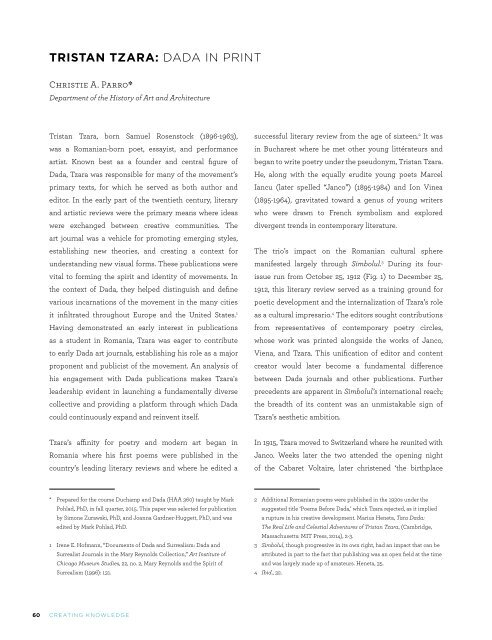UNDERGRADUATE
Ycb5305N2JX
Ycb5305N2JX
Create successful ePaper yourself
Turn your PDF publications into a flip-book with our unique Google optimized e-Paper software.
FIGURE 1<br />
Issue 1 of Simbolul, with cover artwork by Marcel Iancu (Janco),<br />
October 25, 1912. Image originally published in Tom Sandqvist,<br />
Dada East. The Romanians of Cabaret Voltaire, MIT Press,<br />
Cambridge, Massachusetts & London, 2006. ISBN 0-262-19507-0.<br />
FIGURE 2<br />
Cabaret Voltaire, edited by Hugo Ball. Original brochure with cover<br />
illustration by Hans Arp: Kunsthaus Zürich, Library, DADA III:37. 32<br />
pages, 13 illustrations, 27 × 22 cm.<br />
of Dada.’ As World War I ravaged Europe, the tavern on<br />
Spiegelstrasse in neutral Zürich was transformed into the<br />
Cabaret Voltaire by the German poet Hugo Ball (1886-<br />
1927) and his partner, Emmy Hennings (1885-1948). Both<br />
Ball and Hennings placed great value on artistic freedom,<br />
experimentation, and collaboration, and as a product of<br />
their irreverent counter-cultural sensibilities, the cabaret<br />
attracted a diverse entourage of young artists and writers<br />
who sought respite from the war. Resistance to nationalism<br />
and hegemony was evident in the emphasis Dada placed on<br />
diversity and subversion, two concepts that drove Tzara’s<br />
approach to production. While evenings at the cabaret<br />
had gained a level of notoriety for their insurrection, it was<br />
primarily through journals that the news of the movement<br />
was disseminated across Europe. 5<br />
On May 10, 1916, three months after the opening of the<br />
Cabaret Voltaire in Zürich, Tzara wrote to René Gaffé, a<br />
well-connected Belgian collector, in hopes of advancing<br />
Dada further into international consciousness. Together,<br />
Ball and Tzara were organizing a review unlike other arts<br />
and literature publications, one that would take its name<br />
from the Cabaret Voltaire. This letter to Gaffé, coupled<br />
with a June 4, 1916 entry in Hugo Ball’s diary, has received<br />
5 Hoffman, 132.<br />
attention by scholars who, guided by this primary source<br />
material, were able to reconstruct a preliminary draft of<br />
the review Cabaret Voltaire (Fig. 2) before its publication<br />
on June 14, 1916. 6 The motive for Tzara’s letter to Gaffé,<br />
however, was not so much concerned with the edit as it<br />
was a request for Gaffé to inform his friends about the<br />
Cabaret Voltaire. 7 This sort of transaction marks an early<br />
stage of what would quickly evolve into an exchangebased<br />
system of information distribution. Publications<br />
gained currency as they were shared between avantgarde<br />
groups across Europe as a primary means of<br />
communication and in an effort to increase visibility of<br />
contemporary practice.<br />
Ball described the publication broadly as the “first<br />
synthesis of the modern schools of art and literature,” a<br />
communal vehicle for expression. Contributions came<br />
from Dadaists as well as Futurists and Cubists, while<br />
literary works were published in French and German.<br />
In the single-issue review, Ball wrote, “It is necessary<br />
6 A detailed account of the publication’s evolution is outlined in Hellmut<br />
Whol ,“Tristan Tzara, René Gaffé and the Cabaret Voltaire,” The<br />
Burlington Magazine, 149, no. 1249, Collecting in Spain (April 2007):263.<br />
7 Ibid.<br />
DEPAUL UNIVERSITY<br />
61


